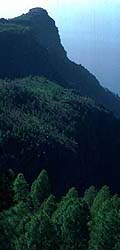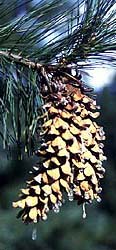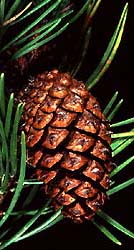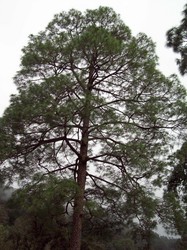Pinus
Pine Trees
David S. Gernandt, Aaron Liston, and Robert A. Price


This tree diagram shows the relationships between several groups of organisms.
The root of the current tree connects the organisms featured in this tree to their containing group and the rest of the Tree of Life. The basal branching point in the tree represents the ancestor of the other groups in the tree. This ancestor diversified over time into several descendent subgroups, which are represented as internal nodes and terminal taxa to the right.

You can click on the root to travel down the Tree of Life all the way to the root of all Life, and you can click on the names of descendent subgroups to travel up the Tree of Life all the way to individual species.
For more information on ToL tree formatting, please see Interpreting the Tree or Classification. To learn more about phylogenetic trees, please visit our Phylogenetic Biology pages.
close boxIntroduction
Pinus, with over 100 species, is the largest genus of conifers and the most widespread genus of trees in the Northern Hemisphere. The natural distribution of pines ranges from arctic and subarctic regions of Eurasia and North America south to subtropical and tropical (usually montane) regions of Central America and Asia. Pines are also extensively planted in temperate regions of the Southern Hemisphere. Many pines are fast growing species tolerant of poor soils and relatively arid conditions, making them popular in reforestation. Important pine products include wood, turpentine, and edible seeds.
Pines have a relatively rich fossil record dating back to the Early Cretaceous, 130 million years ago (reviewed in Axelrod 1986; Klaus 1989; Van der Burgh 1973; Millar 1993).
Discussion of Phylogenetic Relationships
Most classifications of Pinus recognize two major lineages: subgenus Strobus (haploxylon or soft pines, with one fibrovascular bundle in the needle) and subgenus Pinus (diploxylon or hard pines, with two fibrovascular bundles in the needles). This division is consistent with data from wood anatomy and secondary chemistry, and is supported in recent molecular phylogenetic studies (Strauss & Doerksen 1990; Wang & Szmidt 1993; reviewed in Price et al., 1998). The Vietnamese species, P. krempfii possesses unusual flattened needles and a unique wood anatomy. Based on these distinctive features, the species was considered a third subgenus in the influential classification of Little & Critchfield (1969). On the other hand, secondary product chemistry (Erdtman et al. 1966), nuclear ribosomal DNA (Liston et al. 2003) and chloroplast DNA sequences (Wang et al. 1999; Gernandt et al. in press) indicate that P. krempfii should be considered a member of subgenus Strobus.
References
Axelrod, D. I. 1986. Cenozoic history of some western American pines. Ann. Mo. Bot. Gard. 73: 565-641.
Erdtman, H., B. Kimland, and T. Norin. 1966. Wood constituents of Ducampopinus krempfii (Lecomte) Chevalier (Pinus krempfii Lecomte). Phytochemistry 5: 927-931.
Farjon, A. 1984. Pines: Drawings and Descriptions of the Genus. E.J. Leiden, Netherlands: E.J Brill and W. Backhuys.
Gernandt, D. S., G. Geada López, S. Ortiz García, and A. Liston. 2005. Phylogeny and classification of Pinus. Taxon 54: 29-42.
Klaus, W. 1989. Mediterranean pines and their history. Plant Systematics and Evolution 162: 133-163.
Liston, A., D. S. Gernandt, T. F. Vining, C. T. Campbell, and D. Piñero. 2003. Molecular phylogeny of Pinaceae and Pinus. Pp. 107-114 in Mill, R.R. (ed.), Proceedings of the 4th Conifer Congress. Acta Hort 615.
Little, E. L. Jr., and W. B. Critchfield. 1969. Subdivisions of the genus Pinus (pines). USDA Forest Service Misc. publ. 1144.
Millar, C. I. 1993. Impact of the Eocene on the evolution of Pinus L. Ann. Mo. Bot. Gard. 80: 471-498.
Mirov, N. T. 1967. The Genus Pinus. New York: Ronald Press
Price, R. A., A. Liston, and S. H. Strauss. 1998. Phylogeny and systematics of Pinus. Pp. 49-68 in: Richardson, D.M. (ed.), Ecology and Biogeography of Pinus. Cambridge University Press.
Strauss, S. H. and A. H. Doerksen. 1990. Restriction fragment analysis of pine phylogeny. Evolution 44: 1081-1096.
Van der Burgh, J. 1973. Holzer der niederrheinischen Braunkohlenformation, 2. Holzer der Braunkohlengruben "Maria Theresia" zu Herzogenrath, "Zukunft West" zu Eschweiler und "Victor" (Zulpich Mitte) zu Zulpich. Nebst einer systematisch-anatomischen Bearbeitung der Gattung Pinus L. Review of Paleobotany and Palynology 15: 73-275.
Wang, X.-R. and A. E. Szmidt. 1993. Chloroplast DNA-based phylogeny of Asian Pinus species (Pinaceae). Plant Systematics and Evolution 188: 197-211.
Wang, X.-R., Y. Tsumura, H. Yoshimaru, K. Nagasaka and A. E. Szmidt. 1999. Phylogenetic relationships of Eurasian pines (Pinus, Pinaceae) based on chloroplast rbcL, matK, rpl20-rps18 spacer, and trnV intron sequences. Amer. J. Bot. 86: 1742--1753.
Information on the Internet
- Dendrome Project. A central electronic resource for the study of forest tree genomes.
- Pine Products
- Pine taxonomy and classification
Title Illustrations

| Scientific Name | Pinus canariensis |
|---|---|
| Location | Tenerife, Spain |
| Copyright |
© Aaron Liston

|
| Scientific Name | Pinus monticola |
|---|---|
| Body Part | ovulate cone |
| Copyright |
© Aaron Liston

|
| Scientific Name | Pinus contorta |
|---|---|
| Body Part | ovulate cone |
| Copyright |
© Aaron Liston

|
| Scientific Name | Pinus roxburghii |
|---|---|
| Location | Uttarakhand, India |
| Comments | Chir pine (pinus roxburghii) is common in the area, but nothing much grows alongside or in the understory of this plant. |
| Specimen Condition | Live Specimen |
| Source | Chir Pine (Pinus roxburghii) |
| Source Collection | Flickr |
| Image Use |
 This media file is licensed under the Creative Commons Attribution License - Version 2.0. This media file is licensed under the Creative Commons Attribution License - Version 2.0.
|
| Copyright | © 2008 Trees ForTheFuture |
| Scientific Name | Pinus krempfii |
|---|---|
| Body Part | flattened leaves |
| Copyright |
© Aaron Liston

|
About This Page
David S. Gernandt

Universidad Nacional Autonoma de Mexico
Aaron Liston

Oregon State University, Corvallis, Oregon, USA
Robert A. Price

University of Georgia, Athens, Georgia, USA
Correspondence regarding this page should be directed to David S. Gernandt at
Page copyright © 1996 David S. Gernandt, Aaron Liston, and
All Rights Reserved.
- Content changed 24 November 2004
Citing this page:
Gernandt, David S., Aaron Liston, and Robert A. Price. 2004. Pinus . Pine Trees. Version 24 November 2004 (under construction). http://tolweb.org/Pinus/21626/2004.11.24 in The Tree of Life Web Project, http://tolweb.org/















 Go to quick links
Go to quick search
Go to navigation for this section of the ToL site
Go to detailed links for the ToL site
Go to quick links
Go to quick search
Go to navigation for this section of the ToL site
Go to detailed links for the ToL site